| Image | Product | Price |
|---|---|---|
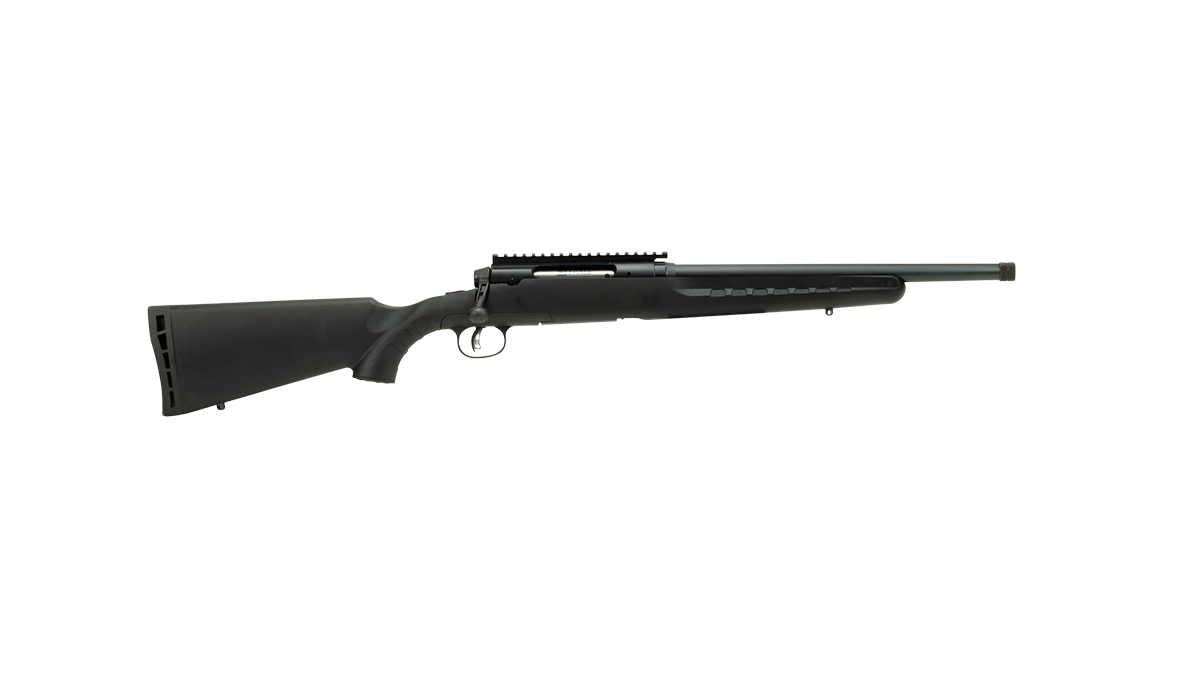 | Check Price | |
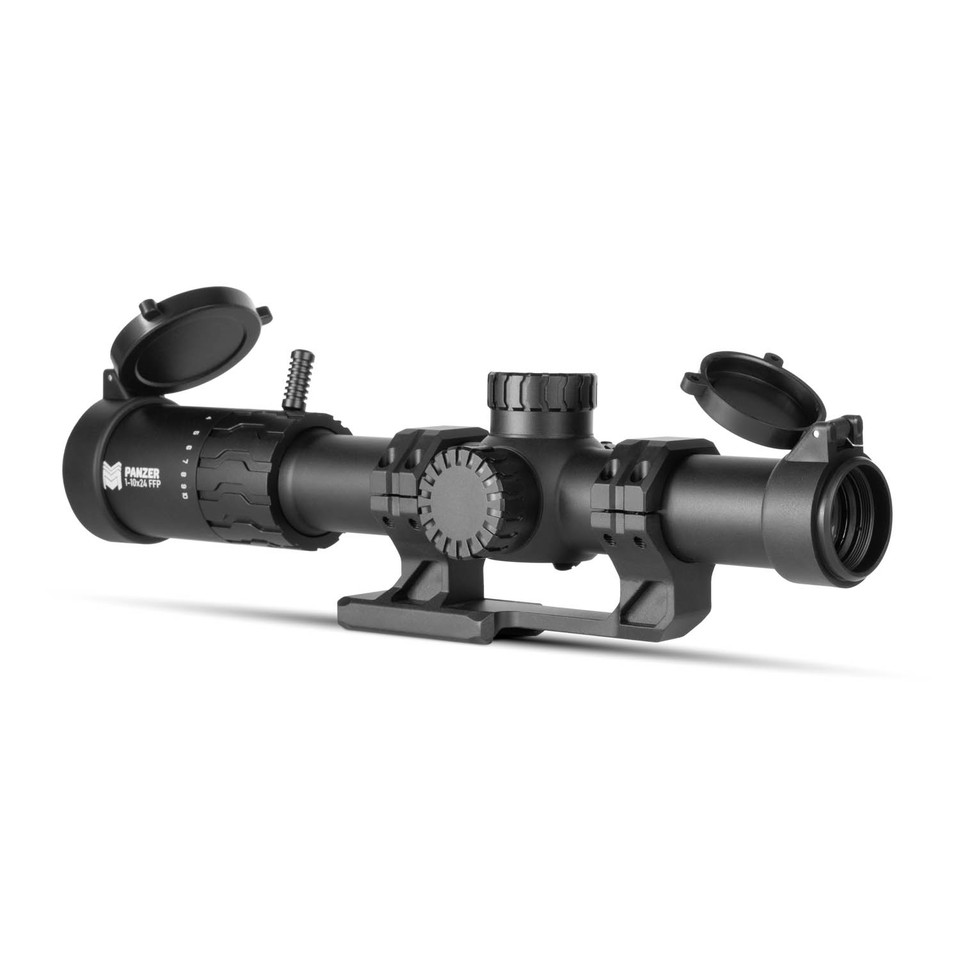 | Check Price |
The .300 Blackout cartridge has gained quite a following in recent years, especially among AR-15 enthusiasts. But what about those looking for a bolt-action option that is even more quiet? Enter the Savage Axis II in .300 Blackout, a budget-friendly rifle that brings this versatile cartridge to the bolt gun world. Pair it with the new Monstrum Panzer 1-10×24 First Focal Plane LPVO and a stealth-mode suppressor, and you’ve got a setup ready for everything from close-quarters hog hunting to midrange target shooting. Let’s dive into this intriguing combo and see what it has to offer.
The Savage Axis II: Affordable Precision
Savage Arms has long been known for producing accurate rifles at reasonable prices, and the Axis II is no exception. This .300 Blackout variant brings a lot to the table for around $400. The synthetic stock is ergonomically designed with a slim grip area and finger grooves up front for a stable hold. A cushy recoil pad at the butt helps tame what little kick the .300 Blackout produces, especially when suppressed.
One of the standout features of the Axis II is Savage’s renowned AccuTrigger. This user-adjustable system allows you to dial in the pull weight from 2.5 to 6 pounds while maintaining a crisp, creep-free break. It’s a feature that is becoming more common in budget rifles and contributes significantly to the gun’s accuracy potential.
Barrel & Action
The .300 Blackout variant of the Axis II sports a 16.125-inch threaded heavy carbon steel barrel with a 1:8 twist rate, perfect for stabilizing the wide range of bullet weights this cartridge utilizes. Savage’s button-rifling process ensures consistency, while their floating bolt head design allows for perfect lug engagement and headspacing. These factors combine to produce impressive accuracy from an affordable package.
The action feeds from a detachable box magazine, making it easy to switch between supersonic and subsonic loads in the field. I also appreciated that the magazine fit flush with the rifle for hunting use. I’ve read reports of extraction issues with .300 Blackout bolt guns, but I haven’t experienced any issues with this rifle. The three-position safety is easy to manipulate and allows you to work the bolt with the safety engaged. Most importantly for our purposes, the muzzle comes threaded 5/8×24 from the factory, ready to accept our chosen suppressor.
Monstrum Panzer 1-10×24 LPVO: Budget Optic, Premium Features
To complement our budget-friendly rifle, we’ve opted for the new Monstrum Panzer 1-10×24 First Focal Plane LPVO (Low Power Variable Optic). At around $200, this scope brings a lot of high-end features to a more accessible price point. The 1-10x magnification range offers true 1x performance for close-quarters use and enough zoom to stretch the .300 Blackout to its effective range of 300 yards.
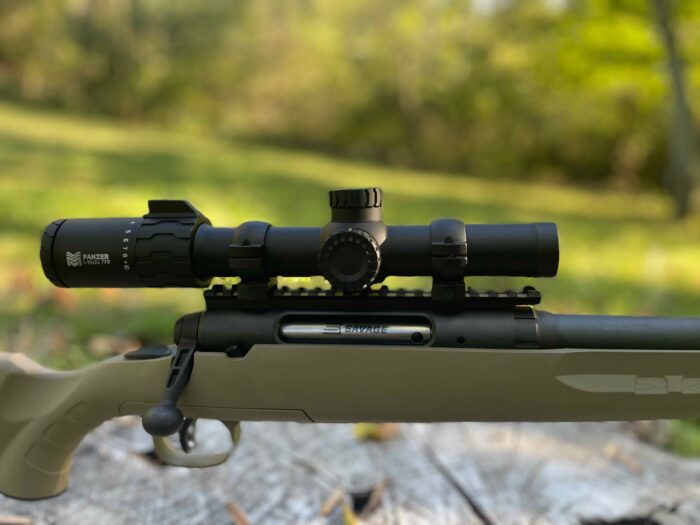
The first focal plane (FFP) design means the reticle size changes as you adjust magnification, allowing for consistent holdovers regardless of zoom level. This is particularly useful with the .300 Blackout, given the significant trajectory differences between supersonic and subsonic loads. The capped turrets offer positive clicks in .2 MIL increments, and while I would prefer .1 MIL increments, it still provides enough precision for the .300 Blackout’s effective range.
Morpheus MM5 Reticle
The Panzer’s new Morpheus MM5 MIL reticle is a standout feature. It offers an illuminated outer crosshair circle reticle and center crosshair when at lower magnifcations for shorter distances, and MIL-based holdover and windage marks for precise shot placement at extended ranges. I found it to have a clean, uncluttered view at low magnification for fast target acquisition and fully capable for longer distances.
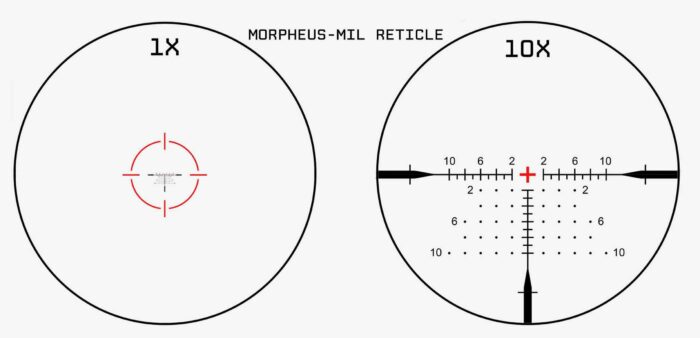
Banish Backcountry: Lightweight Suppression
To complete this versatile setup, I added the Banish Backcountry suppressor from Silencer Central. Weighing in at just 6.9 ounces and measuring only 6.5 inches long, this titanium can adds minimal weight and length to our rifle. It’s rated for calibers up to .300 Win. Mag., making it more than capable of handling anything the .300 Blackout can dish out. A high-performance suppressor like the Backcountry is also a buy-once, cry-once investment that you can use on multiple rifles.
The Backcountry uses a direct-thread attachment, which mates perfectly with the Axis II’s threaded muzzle. This provides a secure, zero-shifting mounting solution. With an average sound reduction of 29.4 dB with .300 Blackout loads, it transforms the shooting experience, especially with subsonic ammunition to sound more like you’re shooting a pellet gun. A bolt gun is also noticeably quieter than an AR-15 in this caliber.
.300 Blackout: One Cartridge, Two Personalities
Before we hit the range, let’s talk about what makes the .300 Blackout so unique. Developed initially for military use, this cartridge was designed to provide .30 caliber power from AR-15 platform weapons without major modifications. It comes in two distinct flavors: supersonic and subsonic.
Supersonic loads typically push 110- to 125-grain bullets at velocities around 2,300 fps, offering ballistics similar to the venerable .30-30 Winchester out to about 300 yards. These are great for hunting deer-sized game or ringing steel at longer distances.
Subsonic loads, on the other hand, lob 190- to 220-grain bullets at around 1,000 fps. These heavy, slow-moving projectiles stay below the speed of sound, making them ideal for use with suppressors. While their effective range is limited to about 100 yards, they offer excellent performance on hogs and other medium-sized game at close quarters.
Range Time: Accuracy and Suppressed Performance
I took the Savage Axis II, Monstrum Panzer and Banish Backcountry to the range on a crisp fall morning to see how they’d perform with a variety of .300 Blackout loads. After a quick bore sight, I had the scope zeroed at 100 yards in just a few shots. The crisp AccuTrigger and clear glass made precise shot placement a breeze.
For supersonic testing, I chose Barnes’ 110-grain TAC-TX FB and SIG Sauer’s 120-grain Elite Copper. The Barnes TAC-TX consistently produced sub-MOA groups at 100 yards. The all-copper construction of this bullet makes it an excellent choice for hunters seeking maximum velocity, terminal performance and weight retention.
The SIG Sauer 120-grain Elite Copper load printed 1.10 inch groups in my test rifle. This load offers a bit more weight for better downrange energy, while still maintaining the benefits of an all-copper projectile. With the Backcountry suppressor attached, the supersonic crack was noticeably reduced, though still present with both loads.
Switching to subsonic rounds, I tested Remington’s 220-grain Open Tip Match and Hornady’s 190-grain SubX. The Remington OTM load produced groups in the 1-inch range. This heavy bullet is designed for accuracy and would be an excellent choice for practice at short to moderate ranges.
The Hornady 190-grain SubX was the top performer of the two subsonic loads. It consistently printed sub-MOA groups at 100 yards. This load is specifically designed for optimal expansion at subsonic velocities, making it an ideal choice for suppressed hunting applications.
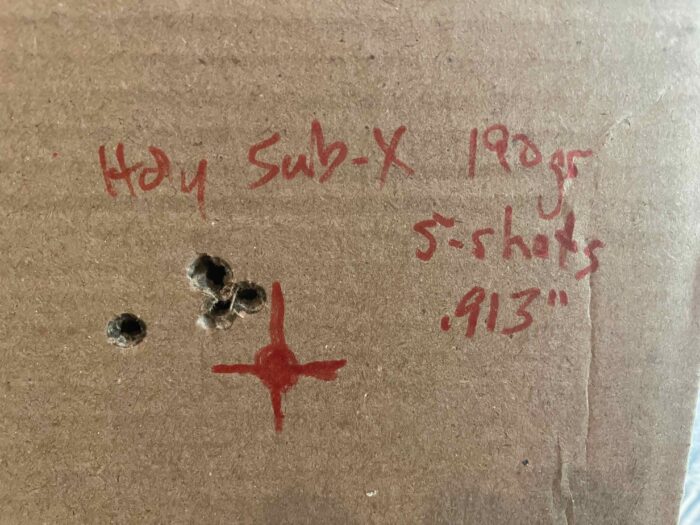
The real magic happened when pairing these subsonic loads with the suppressor. The report was reduced to little more than a quiet thwop, with the loudest noise being the bolt cycling. Of the two subsonic loads, the Hornady SubX seemed to pair best with the suppressor, producing a slightly lower tone that was barely audible beyond 50 yards.
Practical Applications: From the Bench to the Woods
To test the versatility of this setup, I set up a few practical shooting scenarios. First, I engaged steel targets from 25 to 300 yards using the supersonic loads. The 1x setting on the Panzer made close-range hits a breeze, while dialing up to 10x allowed for precise shot placement on the 300-yard target. The Morpheus reticle’s holdover marks proved spot-on once I determined the correct drops for each load. The Barnes TTSX, with its higher ballistic coefficient, showed a slight edge in retained velocity at distance.
Next, I simulated a woods hunting scenario with targets placed at unknown distances from 50 to 150 yards. Here, the Panzer’s 1-6x range proved ideal, offering enough magnification for precision without sacrificing field of view. The illuminated center circle made target acquisition lightning-fast, even in bright daylight. However, I would prefer the lower illumination settings to be less bright to work better in low light hunting conditions. The Banish Backcountry’s minimal added weight was hardly noticeable, preserving the rifle’s handling characteristics. The SIG Elite Copper load shined in this scenario, offering an excellent balance of velocity and energy for deer-sized game at these ranges.
Finally, I set up a hog hunting scenario using subsonic loads and steel targets partially obscured by brush at 50 to 75 yards. Both the Remington OTM and Hornady SubX hit with authority. The subsonic loads’ point of impact was two MILs lower than the supersonics, but I could easily adjust for this using the MIL turrets or the Morpheus reticle’s MIL hash marks. The Hornady SubX had a slight edge here, with its purpose-built expanding subsonic bullet promising excellent terminal performance on tough hogs.
This is where the suppressor truly shined, reducing the rifle’s report to a mere whisper. In a real hunting situation, this setup would allow for follow-up shots without spooking nearby game or even possible shots at additional targets. The combination of the Axis II, Banish Backcountry and Hornady SubX created an impressively quiet and effective hunting rig. I used the setup this fall to harvest a mature Tennessee buck, and it dropped right in its tracks from the Barnes’ 110-grain TAC-TX FB bullet.
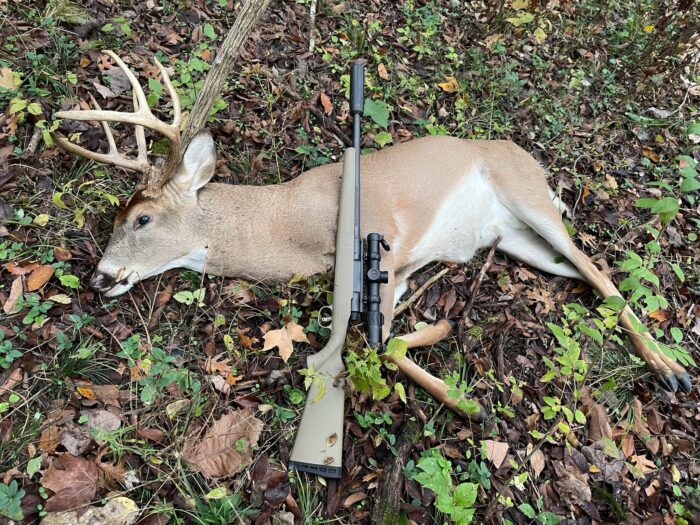
Suppressor-Ready Performance
The combination of the Axis II’s threaded muzzle, the .300 Blackout’s inherent suppressor-friendliness, and the Banish Backcountry makes for an exceptionally quiet shooting experience. The bolt-action design inherently makes for quieter suppressed shooting compared to semi-autos, as there’s no action noise to contend with. For those looking to hunt with maximum stealth, this setup with subsonic loads is hard to beat.
One thing to note is the slight point of impact shift when attaching the suppressor. This is common with most suppressor setups and was easily adjusted for by re-zeroing the scope. Once zeroed with the can attached, accuracy remained consistent whether shooting suppressed or unsuppressed.
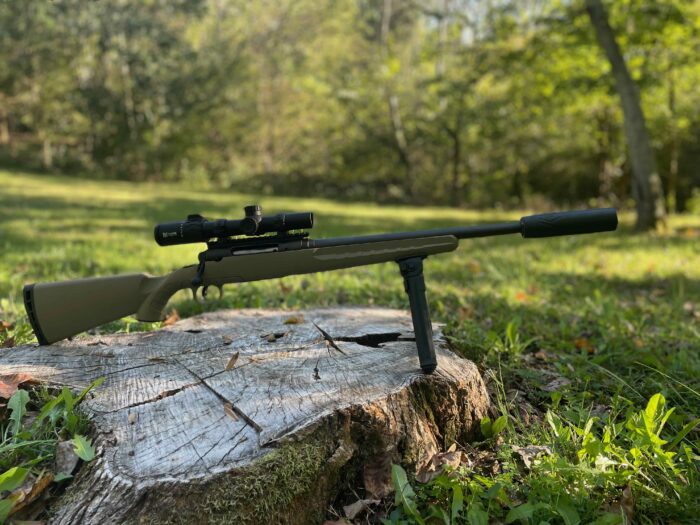
Final Thoughts: Budget-Friendly Versatility
The Savage Axis II in .300 Blackout paired with the Monstrum Panzer 1-10×24 LPVO offers a remarkable amount of versatility at a price point that won’t break the bank. From whisper-quiet close-quarters brush hunting to ringing steel at 300 yards, this combo can do it all with impressive accuracy and stealth, especially when using a suppressor.
The Axis II brings Savage’s reputation for accuracy to the .300 Blackout platform, while features like the AccuTrigger and detachable magazine enhance its usability. The Panzer LPVO scope impresses with its clear ED glass, versatile reticle, and wide magnification range, punching well above its weight class in terms of features and performance for the price. The Banish Backcountry adds suppression capabilities without significantly impacting the rifle’s weight or balance.
For the hunter or shooter looking to explore the capabilities of the .300 Blackout cartridge without venturing into the AR-15 world, this bolt-action setup offers an attractive alternative. Whether you’re chasing whitetails, hunting hogs or just enjoying a day at the range, the Savage Axis II and Monstrum Panzer are up to the task. It’s a testament to how far “budget” rifles and optics have come, delivering high-end performance that would have cost significantly more not that long ago.
Savage Axis II .300 Blackout Rifle Specs
- Stock: FDE Synthetic Sporter
- Action: Bolt
- Metal finish: Matte black carbon steel
- Overall length (in.): 36.625
- Barrel length (in.): 16.125
- Rate of twist: 1 in 8
- Weight (lb.): 6.58
- Optic Ready: Yes
- Magazine capacity: 4
- Manufacturer warranty – general: 1 year limited
Where To Buy
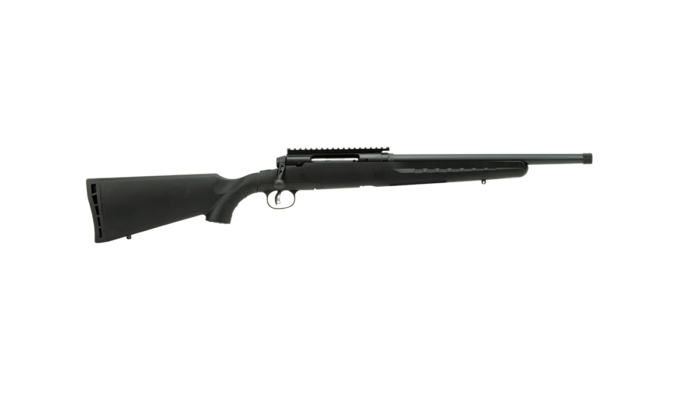
Monstrum Panzer 1-10×24 LPVO Scope Specs
- Magnification Range: 1-10x
- Objective Lens Diameter: 24mm
- Tube Diameter: 30mm
- Focal Plane: First Focal Plane (FFP)
- Reticle: Morpheus MM5 reticle
- Illumination: 11 brightness settings
- Field of View: 116.5 ft – 12.5 ft @ 100 yards
- Eye Relief: 4-4.5 inches
- Click Value: 0.2 MIL per click
- Adjustment Range: 40 MIL (windage and elevation)
- Parallax Setting: Fixed at 100 yards
- Length: 11 inches
- Weight: 17 ounces
- Material: Aircraft-grade aluminum
- Finish: Matte black anodized
- Waterproof: Yes, nitrogen purged
- Shockproof: Yes
- Fog proof: Yes
- Battery Type: CR2032
- Warranty: Lifetime warranty
Where To Buy

Check out Ammo To Go, the ammunition retail sponsor of TTAG, for all of your ammunition needs.
Product and gun reviews are performed independently and product mentions made based on the quality of the product and value of interest to gun owners. However, when you buy through links on our site, we may earn a commission to help support the costs of operating the site and keeping it free for our visitors.

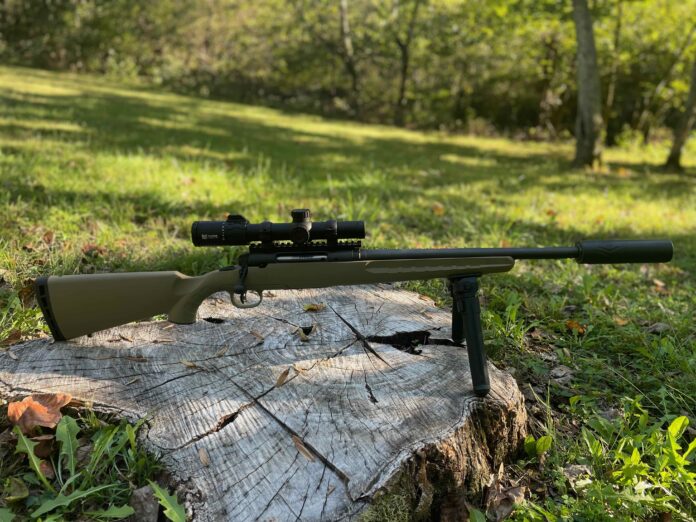
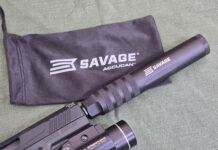


Now that I have a centerfire rifle-rated suppressor, I am looking for a rifle platform which can be VERY quiet out to reasonably limited ranges. This particular rifle just might fit the bill for me. There are two characteristics to this particular platform which appeals to me. First, the .300 AAC Blackout cartridge is fairly well established and I doubt that it will fade into obscurity any time soon. (Along the same lines, there seems to be a decent selection of ammunition available.) Second, this particular rifle’s barrel appears to have a rifling twist rate which is fine for both “light” supersonic bullets and “heavy” subsonic bullets.
I have to research other possible calibers, although I have to admit that no other potential caliber has come to mind thus far. As it is, this article inspired me to quickly search (in a cursory manner) on subsonic .308 Winchester ammunition for example and it looks like subsonic ammunition is VERY expensive and typically out of stock. Ammunition cost and availability alone may push me over the edge to .300 AAC Blackout.
Does anyone know of any other “common” caliber which has readily available ammunition in both subsonic and supersonic flavors (and hopefully at a price on par with other common centerfire rifle calibers)?
Nope. The commonly available, sub and super sonic, affordable (relative but let’s say under a dollar a shot) niche unless I missed something is really narrow. Best I can think of quickly for off the shelf would be 45-70 and you would marginally make 2 out of 3.
Check out 350 Legend. It has subsonic ammo available (from Hornady), and it’s far more powerful than 300 Blackout because it’s a larger, heavier bullet (.355 caliber).
Probably the next closest and it one I generally think about. Still over a dollar a round though.
Hand load and the 308 is more versatile. You can even do sub sonic 30-06 etc.
A friend of mine was talking about putting something like this together when I spoke with him yesterday. He already has a few cans and does AR builds. He has everything for the AR in .300, but wants to pair it with a bolt gun. Don’t know why I didn’t think to suggest the Savage at the time. He’s like me though. He’ll put a Leupold on it.
Gadsden Flag,
I want an insanely quiet rifle that I can use to shoot multiple does when I am out hunting white-tailed deer. Just the other day I had 12 does out in front of me in a 200 yard x 200 yard field. My rifle blast on the first doe sent all the other does running away. If I had been able to shoot that doe without much more than the equivalent of a pellet rifle’s “tink”, I am reasonably confident that I could have taken at least one more doe. (I am only half way to my season harvest goal of four deer.) Now I have to go back out in a couple days and repeat the process–and will probably have to repeat the process yet again when my shot sends the herd running for the hills.
uncommon, I haven’t looked for a few years, but it used to be illegal to hunt with a suppressor in Florida. I never worried about educating the does with a rifle shot. I had enough stands spread over 1000 acres that I would take one here and there with the occasional buck for the wall. Now I mostly shoot quail if I hunt at all. Although, I have a friend with 375 acres in GA that’s a few minutes away. I have a GA license also. I may take a couple of his does for sausage and burger this year. An interesting aside. My neighbor killed his first buck today. A nice 8 pts. He’s a young man that I watched grow up. His parents made the best Mexican food I ever tasted. When they had a fiesta, I ate. Adrian’s parents built a new house a few years ago and he and his bride and child are my neighbors now. The tradition of chow continues. As does the 2A. I would speak with he and his dad occasionally going on and off duty. Like most boys he was curious about my weapons. He bought an AR and a Glock when he became a man. He’s not a Fudd. When he became interested in deer hunting a few months ago he asked me for a little advice. I like to think I had a hand in adding another POTG.
Gadsden Flag,
You are very fortunate to have that much property available to hunt. I am hunting a friend’s property which is 160 acres in total, where something like 80 acres is appropriate for hunting. And of that 80 acres, I am limited at the moment to about 40 acres which is basically harvested fields (soybeans this year). That means the deer scatter when there is a shot anywhere near them–and they scatter away to locations where I cannot hunt them. Thus I am hoping to take two at a time if a herd walks out in front of me–and why I am interested in using my suppressor.
(For reference my state recognizes my right to own and hunt with suppressors–for now anyway.)
Here in CA, I have deer I can literally see from my front porch from time to time, but both suppressors (statewide per law) and hunting (local ordinance) are forbidden. Ouch.
@uncommon
Your bet for a double – forget suppression in re multiple culls.
Shoot not the closest deer. The furthest is ideal, if practical. Don’t be surprised when closer deer get confused and run towards you, or dither in place, when they hear the bullet’s impact. So, your first shot is done with maximum precision. Your second shot is taking your time in a hurry, and aimed at the neck of the doe closest to you. Any miss is likely clean. A hit is likely a drop. You might get more than one shot.
Takes a good semiauto rifle and a good variable scope, in a fast caliber. Keep your FOV set to encompass all of most of the target group.
Caveat: generally speaking it is probably best/safest to just resign yourself to single culls. One bad thing that can happen is you hit an extra accidentally. If you don’t ask me how I know, I won’t lie to you.
uncommon, sorry for the delay in replying. I have no idea of your experience with a suppressor. My first was an MP-5 SD in about 1980. Shot a few since then. Including center fire rifles. Suppressed firearms sound like firearms. They’re just not as loud and sound a little funny. Those extra does will still run. Or will, the second time you try to take a double. Unless, your deer are a little less intelligent than mine.
“Unless, your deer are a little less intelligent than mine.”
I suspect N FL whitetails are as smart as they get – while that is just a suspicion, what I do know is that muledeer (NM, CO, WY) are mentally challenged compared to local whitetails.
Blacktails seem relatively naive as well, but my experience with them is limited.
Gadsden Flag,
I have a question for you. In my comment above, I mentioned that I want a super quiet rifle that I can use with my suppressor to take multiple white-tailed does when they are in a herd out in front of me. I actually already have a 9mm Luger carbine and 147 grain sub-sonic hollowpoint ammunition which is very quiet suppressed. Do you think a 9mm (.355 caliber) 147 grain hollowpoint bullet (at subsonic muzzle velocities) will put a white-tailed doe down quickly if I limit my shots to 50 yards or less?
uncommon, if it’s a brain shot.
“He’s like me though. He’ll put a Leupold on it.”
Absolutely. They used to say a good cowhand would have a 40$ horse and a 100$ saddle – a cheap scope can turn any rifle into a dog.
Gadsden Flag,
Very good. Kind of what I was thinking. (And I will skip trying to land a brain shot–my current carbine setup is not accurate enough to attempt that in an ethical manner.)
As an aside, I shot a doe a week ago with my muzzleloader launching a .45 caliber, 250 grain hollowpoint bullet (Hornady SST-ML) with 100 grains of black powder which should have had an impact velocity every bit of 1,600 feet-per-second. In spite of a double-lung shot (although a tiny bit higher than I normally like), she still ran something like 130 yards before dropping dead. Of course a deer can cover 130 yards in about eight seconds which means she croaked within about eight seconds. It still amazes me that a 150 pound animal (before field dressing) can take a bullet like that and run 130 yards. I cannot imagine any human taking that shot and running 20 yards, much less 80 or 130 yards.
Humans are on the pu$$ side of critters.
If you want quiet use a bow.
Xdduly elected official,
A compound bow or even a crossbow will not work in my hunting location–I am too exposed and the deer are too far away for archery.
A fast truck with a cattle guard?
Fast truck with a cattle guard–that works!
Not certain “fast truck with cattle-guard” is legal hunting gear! Just sayin’!
A 4 round magwell is a lazy execution. Ruger and Mossberg have proven that you can make an AR mag work with a bolt gun. Fail.
Or at least the fairly common AI pattern magazine which other bolt action rifles use. I have 4 10-round magazines for my Ruger Scout.
Jim from LI,
The overwhelming majority of people use bolt-action rifles for hunting or recreational target shooting. People who use bolt-action rifles in those applications typically want a flush-mount magazine rather than a 20 or 30 round magazine sticking down several inches out of the bottom of the rifle. Hence the Axis II series of rifles are optimized for hunting.
Look at it another way. People opt for bolt-action rifles for the greatest accuracy. That means very slow and very careful accurate fire where a limited magazine capacity is not a liability at all. In fact it could even be a benefit since it facilitates more time for the barrel to cool off (due to much more frequent pauses on shooting to reload). People who want much more rapid fire capability will go with a semi-automatic platform such as the AR-15 platform which of course is designed to accommodate 20 and 30 round magazines.
I run my Rem 700 bench rest .308 with 10-round mags and I’ve never been accused of rapid fire.
Magpul setup or one of the nicer ones?
Jim from LI,
I am glad to hear that you have a setup which you like and works for you. The Savage Axis II series is a setup that other people like and works for them.
By the way, in case it wasn’t obvious, some people walk long distances with their rifle when hunting. Those people often want to carry their rifle with a sling over their shoulder. That is very comfortable with a flush-fit magazine–and bordering on impossible with a long magazine sticking out. Like I said in my earlier comments, different solutions for different applications.
Unfortunately AI pattern magazines are single stack so a 10 round magazine can be quite long. But the utility overcomes the inconvenience.
So Fudd. How much hunting do you supposed happens from the prone supported firing position (“need” a short mag)? 0.00001%.
As above “Ruger and Mossberg have proven that you can make an AR mag work with a bolt gun.”
Use a Magpul 10 or 20rd.
Some states limit magazine capacity to 5 rounds unless you use a handgun then it is 7 (law obviously written by a 1911 and old bolt gun owner).
All my .300’s wear a belt.
What can a 300 Blackout do that a 30-30 can’t?
Run in an AR platform, using the same bolt carrier group, and even the same magazine as the .223/5.56.
But but but the article is about bolt action rifles.
30-30 and bolt action are synonymous.
Peter Paul and Muaser chambered their first hit single with the 30-30
You get 300 BLK in a bolt action because you also have it, or plan to have it, in semi-auto.
What do you mean “30-30 and bolt action are synonymous”?!?
The 30-30 and lever action are synonymous; lever-action, not bolt-action! I’ve never seen nor heard of 30-30 in a bolt-action.
Lever-actions and break-action are fine for 30-30, but not bolt-action.
Rem 88 in 30-30. VERY accurate. Scarce as hen’s teeth.
Just saying.
Argh. 788, not 88
Magpul. Can’t complain about Pmags. Easy to load, smooth function, handy release.
Same and between that and actually being available I haven’t had anything to complain about as it was a functional rifle setup for 308.
.300HARM.
Its gotta be good its based on the .223, right.
Anything 5.56 is just better then anything else. That’s what pimdell and palmasino made their target cartridge wildcats out of. A .223 case.
Necked up and down the .223/5.56/.222 Rockchucker has taken every game animal on earth, and did it quietly from long long way off.
Nothing is better.
Oh and I forgot, you can cut back the 5.56/.223 and make 9mm luger cases, or .380 or .30 Muaser, or 7.62×25 Tokerav.
And if you feed it a whole bunch when its little it grows up to be a 30-06.
Nope, 220 Russian, or 7.62×39 is basis for 6 ppc.
Comments are closed.